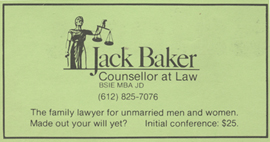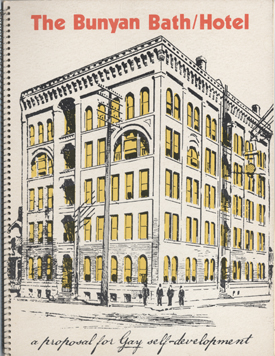Difference between revisions of "Baker Law Associates"
m (Unprotected "Baker Law Associates") |
|||
| (4 intermediate revisions by 2 users not shown) | |||
| Line 15: | Line 15: | ||
Baker and McConnell applied for a marriage license in the [[Old Minneapolis Courthouse/City Hall]] on May 18th, 1970, and the application was subsequently denied.<small>(5)</small> The two sued the County Clerk, lost, and subsequently took their case through the court system, finally appealing to the United States Supreme Court, which dismissed the case. The two later received a license in the city of Mankato, married before a minister, and consider themselves legally married to this day. Baker continued his political activism—he fought the Minnesota Bar Association and became the first openly gay lawyer to practice law. | Baker and McConnell applied for a marriage license in the [[Old Minneapolis Courthouse/City Hall]] on May 18th, 1970, and the application was subsequently denied.<small>(5)</small> The two sued the County Clerk, lost, and subsequently took their case through the court system, finally appealing to the United States Supreme Court, which dismissed the case. The two later received a license in the city of Mankato, married before a minister, and consider themselves legally married to this day. Baker continued his political activism—he fought the Minnesota Bar Association and became the first openly gay lawyer to practice law. | ||
| + | |||
| + | |||
| Line 29: | Line 31: | ||
| − | Along with civil rights advocacy cases, Baker’s law practice was his springboard into local politics--he attempted a run for City Alderman, representing [[Loring Park]]'s district. It was also the sponsor of Bunyan and Co., a "local Gay-owned, Gay-serving development project."<small>(6)</small> Never built, the project was indicative of a separate LGBT society that activists like Baker dreamed of in the 1970s. | + | |
| + | |||
| + | {| {{prettytable}} | ||
| + | ! | ||
| + | ! | ||
| + | |- | ||
| + | |Along with civil rights advocacy cases, Baker’s law practice was his springboard into local politics--he attempted a run for City Alderman, representing [[Loring Park]]'s district. | ||
| + | |||
| + | |||
| + | |||
| + | |||
| + | It was also the sponsor of Bunyan and Co., a "local Gay-owned, Gay-serving development project."<small>(6)</small> Never built, the project was indicative of a separate LGBT society that activists like Baker dreamed of in the 1970s. | ||
| + | |||
| + | |||
| + | |||
| + | |||
| + | The project focused on the economics of Minneapolis/St. Paul's gay marketplace--it noted that 186,000 gay-identified people lived in Minneapolis in 1976, and this combined population had $1,907,683,200 at their disposal.<small>(7)</small> With bluprints, urban planning schematics, and redevelopments costs, the proposing businessmen attemtped to get the city's serious attention. The building, at Hennepin Avenue and Thirteenth, still stands. | ||
| + | | <div style="text-align: center;"> | ||
| + | [[Image:Svc_bunyan.jpg]] | ||
| + | </div> | ||
| + | <div style="text-align: center;"> | ||
| + | <small>'''Cover of the proposal for The Bunyan Bath/Hotel. Courtesy of the [[Jean-Nickolaus Tretter Collection]].'''</small> | ||
| + | </div> | ||
| + | |} | ||
| Line 46: | Line 71: | ||
<small>(6)</small>Bunyan and Co. Advertisement. Twin Cities Pride Guide, 1977. Page 4. | <small>(6)</small>Bunyan and Co. Advertisement. Twin Cities Pride Guide, 1977. Page 4. | ||
| + | |||
| + | <small>(7)</small>The Gay Imperative. "The Bunyan Bath/Hotel: A Proposal for Gay Self-Development." Minnesota: Commercial Traditions Publications, 1976. | ||
Part of [[Minneapolis/St. Paul, MN: 100 Queer Places in Minnesota History, (1860-1969), (1969-2010)]] | Part of [[Minneapolis/St. Paul, MN: 100 Queer Places in Minnesota History, (1860-1969), (1969-2010)]] | ||
Latest revision as of 20:54, 19 January 2012
#412 Loring Park Office Building, 430 Oak Grove Street
Jack Baker is a man of many firsts: he became a member of F.R.E.E.--the first GLBT student group in Minnesota,(1) the first openly gay candidate for the University of Minnesota’s student body presidency (he became the first openly gay student body president), the first person to file suit for gay marriage rights in the United States (with his partner, Michael McConnell in 1971—he did not win)(2), and a participant in the first Twin Cities Pride Festival.(3)
His office was located in the Loring Park Office Building, a 1924 structure that is indicative of property speculation in the 1920s. This building served as the Headquarters of the Northwestern National Life Insurance Company until it left the Loring Park residential/retail neighborhood for downtown in the 1960s. (4) This proved serendipitous for GLBT professionals, who took advantage of the building’s affordable rent and prime location within the “Gay Ghetto.”
Baker and McConnell applied for a marriage license in the Old Minneapolis Courthouse/City Hall on May 18th, 1970, and the application was subsequently denied.(5) The two sued the County Clerk, lost, and subsequently took their case through the court system, finally appealing to the United States Supreme Court, which dismissed the case. The two later received a license in the city of Mankato, married before a minister, and consider themselves legally married to this day. Baker continued his political activism—he fought the Minnesota Bar Association and became the first openly gay lawyer to practice law.
| Along with civil rights advocacy cases, Baker’s law practice was his springboard into local politics--he attempted a run for City Alderman, representing Loring Park's district.
|
Cover of the proposal for The Bunyan Bath/Hotel. Courtesy of the Jean-Nickolaus Tretter Collection. |
(1) "F.R.E.E. Records," Box 1 of the Queer Student Cultural Center Collection, Jean-Nickolaus Tretter Collection in GLBT Studies, University of Minnesota Libraries.
(2)"Gay Pair File Joint Tax Return" The Tri City Herald, 4/19/1971. Page 9.
(3)According the Jean-Nickolaus Tretter, who also participated in the landmark event.
(4)Tretter, Jean-Nickolaus. "The Existence of a Gay Ghetto in Minneapolis." St. Paul, MN: Undergraduate paper submitted to the University of Minnesota’s Geography Department, 1976.
(5)"2 Homosexuals Lose Plea to Get Married." The Milwaukee Journal, 11/26/1970. Page 4.
(6)Bunyan and Co. Advertisement. Twin Cities Pride Guide, 1977. Page 4.
(7)The Gay Imperative. "The Bunyan Bath/Hotel: A Proposal for Gay Self-Development." Minnesota: Commercial Traditions Publications, 1976.
Part of Minneapolis/St. Paul, MN: 100 Queer Places in Minnesota History, (1860-1969), (1969-2010)





